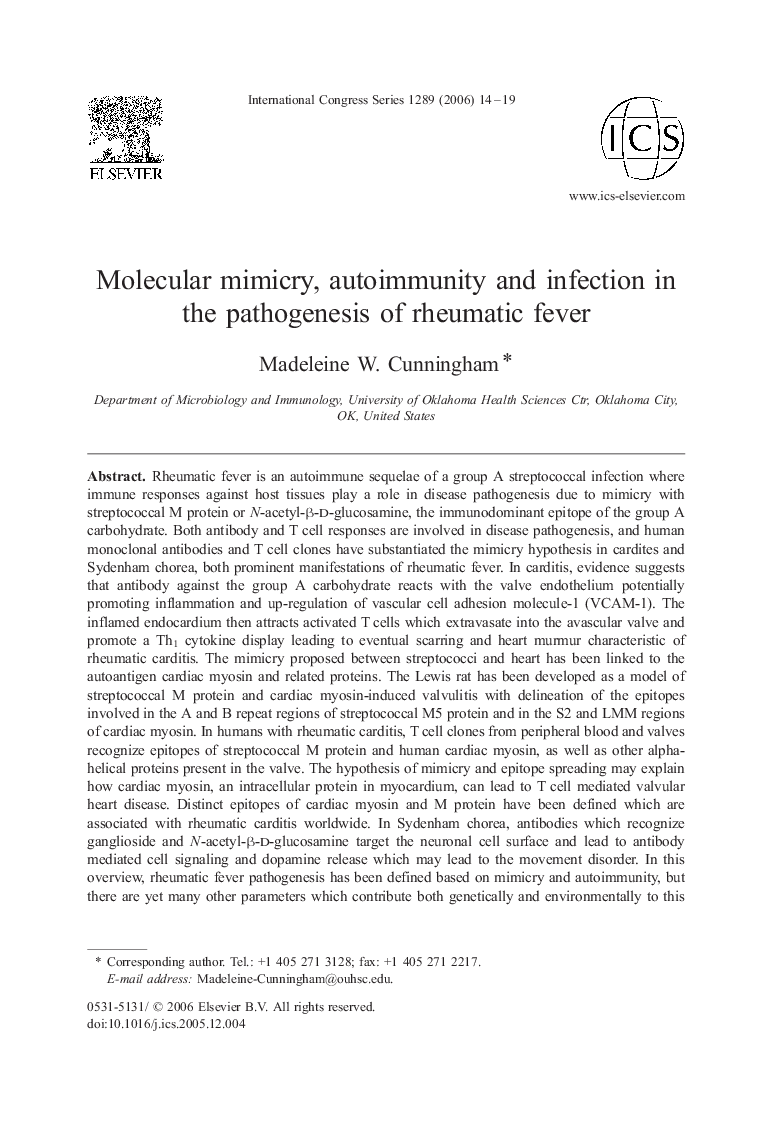| کد مقاله | کد نشریه | سال انتشار | مقاله انگلیسی | نسخه تمام متن |
|---|---|---|---|---|
| 2577397 | 1561368 | 2006 | 6 صفحه PDF | دانلود رایگان |

Rheumatic fever is an autoimmune sequelae of a group A streptococcal infection where immune responses against host tissues play a role in disease pathogenesis due to mimicry with streptococcal M protein or N-acetyl-β-d-glucosamine, the immunodominant epitope of the group A carbohydrate. Both antibody and T cell responses are involved in disease pathogenesis, and human monoclonal antibodies and T cell clones have substantiated the mimicry hypothesis in cardites and Sydenham chorea, both prominent manifestations of rheumatic fever. In carditis, evidence suggests that antibody against the group A carbohydrate reacts with the valve endothelium potentially promoting inflammation and up-regulation of vascular cell adhesion molecule-1 (VCAM-1). The inflamed endocardium then attracts activated T cells which extravasate into the avascular valve and promote a Th1 cytokine display leading to eventual scarring and heart murmur characteristic of rheumatic carditis. The mimicry proposed between streptococci and heart has been linked to the autoantigen cardiac myosin and related proteins. The Lewis rat has been developed as a model of streptococcal M protein and cardiac myosin-induced valvulitis with delineation of the epitopes involved in the A and B repeat regions of streptococcal M5 protein and in the S2 and LMM regions of cardiac myosin. In humans with rheumatic carditis, T cell clones from peripheral blood and valves recognize epitopes of streptococcal M protein and human cardiac myosin, as well as other alpha-helical proteins present in the valve. The hypothesis of mimicry and epitope spreading may explain how cardiac myosin, an intracellular protein in myocardium, can lead to T cell mediated valvular heart disease. Distinct epitopes of cardiac myosin and M protein have been defined which are associated with rheumatic carditis worldwide. In Sydenham chorea, antibodies which recognize ganglioside and N-acetyl-β-d-glucosamine target the neuronal cell surface and lead to antibody mediated cell signaling and dopamine release which may lead to the movement disorder. In this overview, rheumatic fever pathogenesis has been defined based on mimicry and autoimmunity, but there are yet many other parameters which contribute both genetically and environmentally to this globally devastating disease in children. The challenge is to discover them in the years to come.
Journal: International Congress Series - Volume 1289, April 2006, Pages 14–19